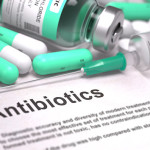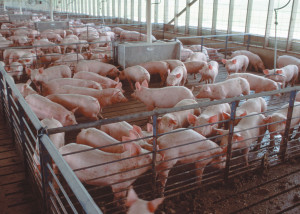Over the last 50-60 years, we have seen a rapid shift from small diverse family farms and grazing operations towards large industrial confinement operations. But while the industrialization of farming has resulted in an abundance of so-called ‘cheap’ meat, eggs and dairy products, we now know there are significant hidden costs—including to our health.
Antibiotic-Resistant Bacteria
 The development of antibiotics was hailed as one of the most important advances in modern medicine. Yet we are on the brink of losing these miracle drugs—and industrial farming is one of the key causal factors. Scientists around the world now emphatically link the routine use of antibiotics in intensive livestock farming to the dramatic rise in antibiotic-resistant bacteria, or “superbugs.”
The development of antibiotics was hailed as one of the most important advances in modern medicine. Yet we are on the brink of losing these miracle drugs—and industrial farming is one of the key causal factors. Scientists around the world now emphatically link the routine use of antibiotics in intensive livestock farming to the dramatic rise in antibiotic-resistant bacteria, or “superbugs.”
Today, almost all intensively farmed animals in the U.S. receive regular low levels of antibiotics in feed or water. But they are not given to treat sickness: these drugs are used to help farmers keep ever-greater numbers of animals in close confinement without the risk of disease outbreaks, and to increase productivity. In the U.S., we use more antibiotics per pound of meat produced than any other nation. The USDA estimates 80% of all antibiotics produced in the U.S. are used in food animal production—over 32 million pounds in 2013 alone.
The problem is that using low doses of antibiotics naturally selects for resistance. When bacteria are exposed to low doses of antibiotics, some get stronger and harder to kill and these stronger bacteria can quickly spread between animals and farms. Bacteria can also exchange resistant traits with different species that have never been exposed to the antibiotic. As a result, some dangerous strains of bacteria found in animals, such as E. coli, salmonella and S. aureus, have mutated and are now resistant to multiple antibiotics. If you get infected with an antibiotic-resistant strain of E. coli, salmonella or S. aureus, what was once a low-risk, easy-to-treat disease can quickly develop into a life-threatening illness.
Industry Response
 For decades, the U.S. industrial farming lobby denied any causal link between antibiotics in intensive farming systems and antibiotic-resistant bacteria (and continues to do so). But in response to growing public concern, we have seen a number of industry developments on antibiotic use in food production.
For decades, the U.S. industrial farming lobby denied any causal link between antibiotics in intensive farming systems and antibiotic-resistant bacteria (and continues to do so). But in response to growing public concern, we have seen a number of industry developments on antibiotic use in food production.
In 2013, the U.S. Food and Drug Administration introduced voluntary recommendations to phase out the use of antibiotics as growth promoters and require veterinary approval of antibiotics in feed and water (although leading critics claim it will do little to decrease the overall quantities of antibiotics used on farms). More recently, several major players launched various farm antibiotic initiatives, including Perdue Foods, Tyson Food, Cargill and McDonald’s. In May 2015, Walmart became the first major retailer to introduce voluntary guidelines limiting suppliers to only using antibiotics to treat and prevent disease (and not for growth promotion).
Of course, the devil is in the detail: loopholes and caveats mean many of these initiatives will do little to reduce antibiotic use or the development of antibiotic resistance. For example, McDonald’s recently announced they will source chicken “raised without antibiotics that are important to human medicine.” A closer examination of their plans, however, reveals the human drugs they intend to prohibit from their supply chain are not presently approved for use in food animals. In other words, McDonald’s is triumphantly prohibiting drugs that would probably never be used in food animal production anyway. What’s more, the fast food giant’s plans do nothing to address the continued use of antimicrobial drugs identified as critically important to human medicine and approved for food animal use. So nothing has really changed.
Similarly, recent marketing initiatives to promote “antibiotic-free” meat and livestock products (where antibiotics are ‘banned’) won’t solve antibiotic resistance or aid sustainable food production. Most “antibiotic-free” farms are industrial confinement operations, with the same old welfare and environmental problems. The label simply encourages a two-tier food system where wealthy people are hoodwinked into paying more for better meat, while the vast majority continue to buy ‘affordable’ meat, eggs and dairy from mainstream industrial farms where routine antibiotics are still used (read our blog on the antibiotic-free label). Banning antibiotics is not the answer and will only lead to welfare problems. What we need are fundamental changes to the industrial farming model.
Other Health Concerns
 As our diets have changed to incorporate the ever-increasing availability of so-called ‘cheap’ meat and dairy products and highly processed food, devastating diet-related diseases—like heart disease, Type 2 diabetes and some diet-related cancers—have reached epidemic levels in the U.S. In 2008, 33.8% of U.S. adults were diagnosed as clinically obese, while one in three people born in 2000 in the U.S. will develop Type 2 diabetes by 2050. But the impact on our children is the most worrying of all: Obesity rates among U.S. pre-school age children—we’re talking about kids of just two to five years old—increased from 5% to 10.4% between 1976 and 2008. During the same period, obesity among six to 11-year-olds increased from 6.5% to 19.6%, while obesity among 12 to 19-year-olds rose from 5% to 18.1%.
As our diets have changed to incorporate the ever-increasing availability of so-called ‘cheap’ meat and dairy products and highly processed food, devastating diet-related diseases—like heart disease, Type 2 diabetes and some diet-related cancers—have reached epidemic levels in the U.S. In 2008, 33.8% of U.S. adults were diagnosed as clinically obese, while one in three people born in 2000 in the U.S. will develop Type 2 diabetes by 2050. But the impact on our children is the most worrying of all: Obesity rates among U.S. pre-school age children—we’re talking about kids of just two to five years old—increased from 5% to 10.4% between 1976 and 2008. During the same period, obesity among six to 11-year-olds increased from 6.5% to 19.6%, while obesity among 12 to 19-year-olds rose from 5% to 18.1%.
Industrial farming systems are bad for our health in other ways. Toxic emissions from industrial farms—including gases, particulates and bioaerosols such as hydrogen sulphide, fecal waste dust, pharmaceutical residues and bacteria—are having serious adverse health effects on U.S. citizens who live nearby. When examining the health of local communities in a region of North Carolina that is densely populated with industrial hog operations, numerous studies have found residents suffer acute physical symptoms, including eye and nasal irritation, respiratory symptoms, difficulty breathing, wheezing, chest tightness, and nausea, as well as anxiety and other nervous disorders. The evidence is so great that one study concluded that “Exposure to air pollution from hog operations is an environmental injustice in rural areas hosting facilities that supply pork to populations spared the burdens of its production.” Unfortunately, many of these communities are among the poorest in America.
TAKE POSITIVE ACTION
No farming system can guarantee animals will never get sick. But raising animals outdoors on pasture and in ways that maximize natural immunity and minimize stress will get pretty close—and results in far wider benefits. At AGW, we believe antibiotics must always remain in the farmers’ toolbox to treat illness and prevent suffering in animals, which is why our farm certifications allow antibiotics only to treat sick or injured animals and where alternative treatments are not deemed effective or appropriate.
For health reasons, we all need to cut back on the amount of unhealthy, intensively-reared meat, eggs and dairy we consume—and choose high-welfare, pasture-based food instead. The comparative health benefits of pasture-based and grassfed beef against feedlot beef, for example, are already well documented. As well as having less total fat, saturated fat, calories and cholesterol, research shows that grassfed beef has more vitamin E and C, beta carotene, and health-producing fats like omega 3s and CLAs.
Finally, we know that well-managed pasture-based farming systems do not result in the same health-threatening pollution problems found on industrial farms, as animal manure is naturally deposited as the livestock are moved across the land, rather than stored in vast outdoor cesspools.
Next:
Industrial farming leads to major environmental pollution problems…
Be part of the solution:
Find out how your daily food choices can help fix our broken food system here!
